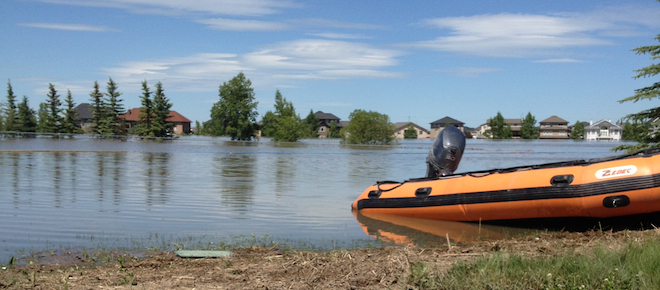High River prepares flood re-entry plan as tensions mount
Residents in least flooded areas to get in first
Share

It wasn’t quite the news High River residents were waiting for today, but it’s getting closer.
At his daily media update, High River Mayor Emile Blokland announced that the town will have details of its re-entry plan as of Friday at 12:30 p.m. The news comes more than a week after 13,000 residents were forced from their homes when the Highwood River flooded and covered nearly all of the town in water on Thursday, June 20. The town has been under a mandatory evacuation order ever since, with RCMP officers stationed at each entrance to town to limit access.
The details of the re-entry plan can’t come soon enough. Tensions rise with each passing day that residents are barred from getting back to their homes. Around the same time Blokland was making his announcement, angry residents were gathering at the northwest entrance to town in protest. On Wednesday night, three residents got into High River through the perimeter, but were arrested by RCMP. Charges against them are pending.
It’s easy to see why residents are frustrated. My parents, whose High River home was undoubtedly damaged in the flood, have a four-wheel-drive truck loaded with a pump, extra lengths of hose, three bottles of bleach, rubber boots and gloves. They’re ready to get into the house, assess the damage, and get that pump running. It’s a shame to have a pump sitting idle at a time like this, my step-father said yesterday.
The town, however, wants to ensure everything is safe before residents get back in. “We cannot let folks return to homes until all the re-entry criteria have been met,” Blokland said. Some of these criteria include getting sewage, power and water back online.
Though the exact details of the plan will be released Friday, there were some hints at what residents can expect.
First, the re-entry plan will be in stages and not everyone will be let in right away. The re-entry plan will start with the least affected neighbourhoods and move on from there.
Travelling through High River on a media tour today, it was a bit surreal to see some areas that look pretty normal in the southeast part of town. Streets are dry and there is little or no flood debris. There were houses like the one below, where it just looks like the residents went on vacation:

Then, move a few blocks to the north and Sunshine Lake, usually a small man-made lake, is way larger than usual. Still, a week after the flood, water in this area of town extends into the walk-up basements of the homes that face the lake.

Further north, in a newer subdivision called The Hamptons, things look even worse. Before the flood, there was no water here at all. Now there is a large stagnant lake that refuses to drain.
Work crews are building a berm here to help them pump out water in sections and to ensure it doesn’t fill back in once they pump it out. In the Sunshine Lake area they’re already pumping, using three industrial pumps that would be used in oil and gas fracking, as well as irrigation pumps.

It’s obvious that some residents are much worse off than others.
Officials have inspected every residence where it is possible to get in and have assigned each building a category. Those in the first category will get a green-light, meaning there was no damage and residents are able to move in right away.
From there, there are three more categories, says Jim Cornish, who works for the Alberta Emergency Management Agency.
“The second category, or yellow, is a home that has been affected by the water, but is safe to inhabit immediately and the residents can get in and clean it up themselves,” Cornish says. “Category three are homes that have been damaged to the point that it’s not safe to let people move into them currently, but they can be remediated.”
And the final category, no one wants to be in that. “Category four are those homes that have been damaged so severely that, whether their foundations have been ruined, the structure of the house has actually shifted — that they’ll have to be completely rebuilt,” says Cornish.
I still haven’t seen my parents’ home, but I’d expect it to be in the third category, maybe the second if we’re lucky. The home is still standing, but it’s near the river and there is undoubtedly a lot of water in the basement.
As I’ve met with residents over the past few days, everyone keeps asking for good news. There is some good news for today:
- Residents don’t have to pay their June property taxes until September 1.
- The town is waiving May and June utility bills.
- The province released $50 million of the $1 billion it has pledged in flood aid to the town of High River. It’s the first place in the province to see the dollars that will be used to help rebuild.
- There are a lot of mosquitoes in town, due to large amounts of standing water, but the mosquitoes aren’t the same kind that carry West Nile virus, says the province’s chief medical officer of health Dr. Richard Musto. (Note to residents: Seriously, though, the mosquitoes are horrible. Get a couple of cans of mosquito spray before you come back in.)
I’ll post more details on re-entry tomorrow. They will also be on the Alberta government’s flood recovery website, the Town of High River Facebook page and at the toll-free flood recovery information line: 310-4455.